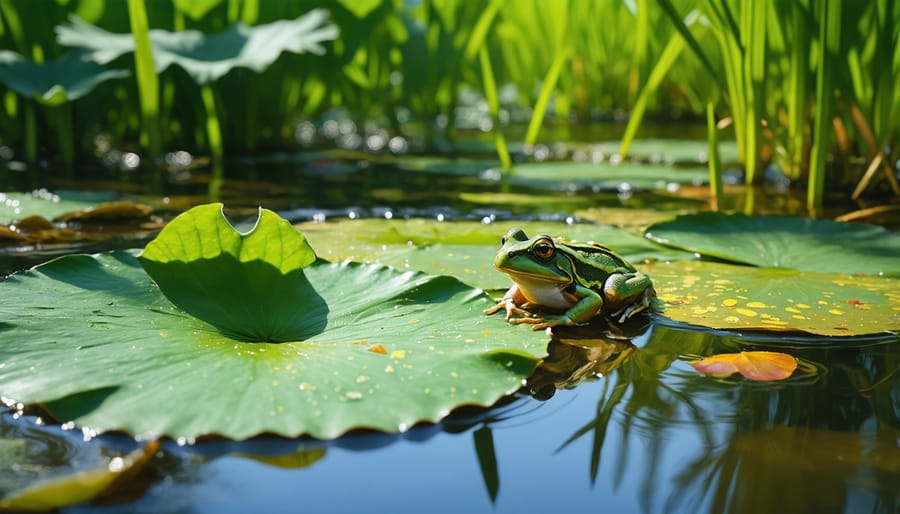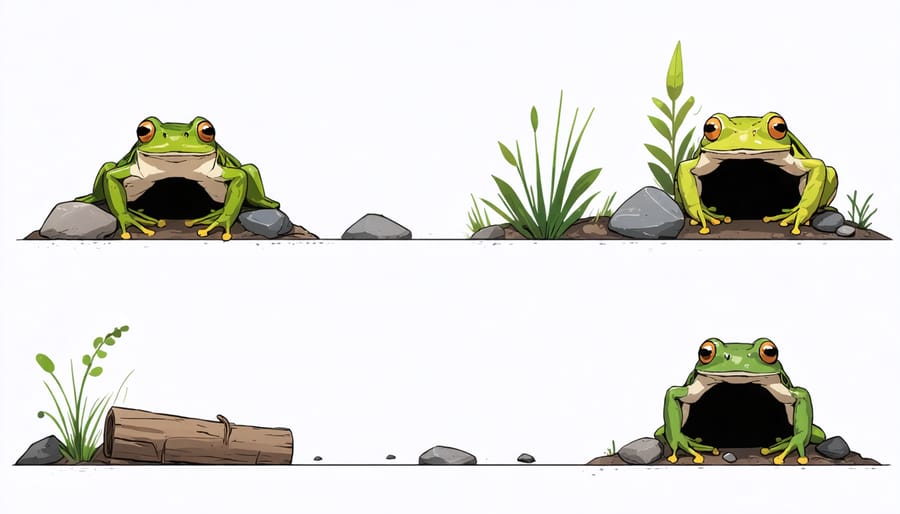
Transform Your Ordinary Pond into a Thriving Frog Habitat
Unlock the secrets of a thriving frog habitat in your backyard pond with Frog Pond Wildlife Management Area. Assess your pond’s suitability by ensuring it has shallow areas, vegetation, and clean water. Design the perfect frog paradise with native aquatic plants, floating logs, and plenty of hiding spots. Attract frogs by creating a thriving pond ecosystem that includes their favorite foods like insects, tadpoles, and small fish. Maintain the delicate balance by monitoring water quality, avoiding chemicals, and providing year-round care. With dedication and these proven strategies, you’ll soon hear the enchanting croaks and ribbits of your very own frog oasis.
Assess Your Pond’s Suitability

Location and Surroundings
When choosing a location for your frog pond, look for a spot that receives both sun and shade throughout the day. Partial shade helps regulate water temperature and prevents excessive algae growth. Avoid low-lying areas prone to flooding or near sources of pollution like roads or septic systems.
Surround your pond with a diverse mix of native vegetation to create a welcoming habitat for frogs. Include emergent plants like cattails and rushes along the shallow edges, providing hiding spots and perches. Submerged plants such as hornwort and waterweed offer oxygen and shelter for tadpoles. Don’t forget floating plants like water lilies to provide shade and resting spots for adult frogs.
Create a buffer zone of longer grasses, shrubs, and wildflowers around the pond to offer additional cover and foraging opportunities. This naturalized area also helps filter runoff before it enters the pond, maintaining water quality. With thoughtful placement and lush surroundings, your frog pond will become a thriving ecosystem.
Water Quality and Depth
Maintaining optimal water quality and depth is crucial for creating a thriving frog habitat in your pond. Amphibians are sensitive to water conditions, so aim for a pH level between 6.5 and 7.5. Regularly test the water using a pond kit and make adjustments as needed. Frogs also require varying water depths to accommodate their different life stages. Include shallow areas (1-2 inches deep) for tadpoles and deeper sections (18-24 inches) for adult frogs to overwinter. Submerged plants like hornwort and water lilies help oxygenate the water and provide shelter. Avoid using chemicals or pesticides near the pond, as they can harm frogs and other wildlife. Instead, rely on natural filtration methods such as beneficial bacteria and aquatic plants to maintain water clarity. By creating optimal water conditions and depths, you’ll attract frogs and establish a balanced, self-sustaining ecosystem in your frog pond.
Creating the Perfect Frog Habitat

Provide Shelter and Hiding Spots
To provide shelter and hiding spots for frogs in your pond, incorporate a variety of natural elements such as rocks, logs, and aquatic plants. Start by placing large, flat rocks along the pond’s edge, creating a gradual transition from land to water. These rocks not only offer basking spots for frogs but also provide cover from predators. Next, add some partially submerged logs or driftwood to the shallow areas of the pond. Frogs will use these to rest and hide among the crevices. Aquatic plants are another essential component of frog refuges. Include a mix of emergent, submergent, and floating plants to create a diverse habitat. Emergent plants like cattails and rushes provide excellent vertical structure for frogs to climb and hide. Submergent plants such as hornwort and waterweed offer underwater cover and help maintain water quality. Floating plants like water lilies and pondweed create shaded areas and additional hiding spots on the water’s surface. By strategically placing these elements throughout your pond, you’ll create a welcoming environment for frogs to thrive, while also enhancing the overall aesthetic appeal of your water garden.
Establish Varying Water Zones
When designing your frog pond, create varying water depths to cater to different frog species and life stages. Shallow areas, around 2-4 inches deep, provide basking spots for adult frogs and are crucial for tadpoles to metamorphose into froglets. Deeper zones, ranging from 18-24 inches, offer refuge from predators and overwintering spots. Gradually slope the pond bottom to create a seamless transition between these zones. Use rocks, logs, or planted shelves to establish different levels within the pond. This diversity in water depth not only enhances the aesthetic appeal of your pond but also ensures that frogs have access to the specific habitats they need to thrive. By incorporating varied water zones, you’ll be one step closer to creating an inviting oasis that supports a vibrant frog population throughout their life cycle.
Incorporate Native Plants
When selecting plants for your frog pond, opt for native species that naturally thrive in your region. Indigenous aquatic plants are well-adapted to local conditions and provide ideal habitats for frogs. Consider incorporating a mix of submerged, floating, and marginal plants to create a diverse ecosystem. Submerged plants like hornwort and waterweed oxygenate the water, while floating plants such as water lilies and frogbit offer shade and resting spots for frogs. Marginal plants, including rushes, sedges, and cattails, provide shelter and breeding areas along the pond’s edge. Not only do native plants support frog populations, but they also contribute to the overall health and aesthetic appeal of your pond. By choosing indigenous species, you’ll create a thriving, low-maintenance environment that attracts frogs and other wildlife to your backyard oasis.
Maintaining Your Frog-Friendly Pond
Avoid Chemicals and Pollutants
To maintain a healthy frog habitat, it’s crucial to avoid using chemicals and pollutants near the pond. Pesticides, herbicides, and fertilizers can harm frogs and other pond wildlife. Instead, opt for natural methods to control pests and promote plant growth. Encourage beneficial insects like ladybugs and praying mantises, which prey on pests. Use organic compost to nourish plants and improve soil quality. If you must use any products, choose eco-friendly, biodegradable options specifically designed for use around ponds. Keep the area surrounding the pond free of litter and debris, as these can introduce harmful substances into the water. By minimizing the use of chemicals and pollutants, you’ll create a safe and thriving environment for frogs and other pond inhabitants to flourish.
Perform Regular Cleanings
To keep your frog pond thriving, regular cleaning is essential. Start by removing any fallen leaves, twigs, or debris that accumulate on the water’s surface using a pond skimmer or net. This prevents organic matter from decomposing and affecting water quality. Next, tackle algae growth by physically removing it with a brush or rake, being careful not to disturb the frogs or other wildlife. For stubborn algae, consider using natural treatments like barley straw or beneficial bacteria that break down excess nutrients. Periodically check and clean the pond filter to ensure it’s functioning optimally. During cleaning, avoid using harsh chemicals that can harm the delicate ecosystem. With consistent maintenance, you’ll create a clean and healthy environment where your frogs and other pond inhabitants can flourish.

Monitor and Manage Frog Population
Monitoring and managing your frog population is crucial to maintaining a healthy ecosystem in your pond. Keep an eye out for signs of overcrowding, such as frogs appearing thin or lethargic, or an increase in aggressive behavior. If you notice these issues, consider relocating some frogs to another suitable habitat. Regularly assess the water quality and make adjustments as needed to ensure a balanced environment for your amphibian friends.
To track frog activity, consider keeping a log of the different species you observe, their numbers, and any notable behaviors. This information can help you identify potential problems early on and take appropriate action. Additionally, be mindful of the breeding season and provide extra space and resources during this time to accommodate the increased population. With careful monitoring and management, you can ensure your frog pond remains a thriving and vibrant ecosystem for years to come.
Conclusion
Creating a thriving frog pond habitat is a rewarding experience that benefits both the environment and your enjoyment of your outdoor space. By assessing your pond’s suitability, designing a diverse habitat, and maintaining a healthy ecosystem, you can attract a variety of frog species and other wildlife to your backyard oasis. Remember to provide a mix of shallow and deep areas, incorporate native aquatic plants, and offer hiding spots like logs and rocks. Regularly monitor water quality, remove invasive species, and avoid using harmful chemicals to ensure a balanced and sustainable habitat. With patience and dedication, you’ll soon be greeted by the melodic croaks and chirps of happy, healthy frogs. Your thriving frog pond will not only provide a sanctuary for these fascinating creatures but also contribute to the conservation of local biodiversity. So, embrace the opportunity to create a haven for frogs and other wildlife, and enjoy the tranquility and beauty of your very own frog pond wildlife management area.
